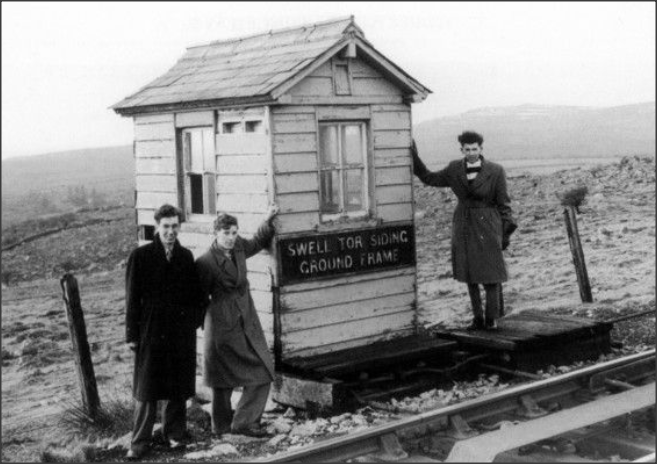About Swelltor Siding
Swelltor Quarry, once a vital part of the local granite industry, had a significant role in the history of the Princetown Railway. The railway passed along the slopes of King Tor, running beneath the extensive yet disused workings of Swelltor Quarries. These quarries, known for producing high-quality granite, had their own sidings branching off from the main line at Swelltor, specifically at milepost 7¾.
Swelltor Siding, also referred to as the Royal Oak Siding, was controlled by a ground frame. This yellow signal box stood out from across the moor, even though by the time most travellers were using the line, the quarry was no longer operational. Despite the closure of the quarry, the sidings remained a distinctive feature along the line. The layout included a forward siding running off the line in the “down” direction, with a much longer reverse siding extending into the quarry itself. A passing loop was provided on the reverse siding, which allowed for more efficient shunting operations.
The train’s journey through this section was marked by a noticeable change in scenery as it passed the granite overbridge and negotiated a tight curve around milepost 8. Travellers enjoyed sweeping views of the surrounding moor, with Great Mis Tor looming in the distance at 1,760 feet above sea level. Though the quarry itself was no longer active, the trackbeds that once connected the railway to the quarry workings were often used as cart tracks or footpaths, hinting at the area’s industrial past.
Despite its relatively remote location, Swelltor remained a vital part of the line’s operations during its peak. While the quarry ceased active operations long before the line’s closure, it left a lasting mark on the landscape, with remnants of its infrastructure still visible to those exploring Dartmoor today.
In Brief
The information provided on the Ordnance Survey map surveyed in 1883 and published in 1885 does not provide a clear understanding of the situation at the Swell Tor Quarries on Dartmoor. On one hand, it indicates that the railway to Princetown was owned by the Great Western Railway Company, while on the other hand, it still displays the mile markers that unmistakably belong to the Plymouth and Dartmoor Railway.
In the vicinity of Mile Post 20, starting from Plymouth, the map illustrates a loop on the single line, accompanied by a small building on the northern side. Extending from this loop, there is a lengthy siding that winds its way up the north-eastern slope to the Swell Tor Granite Quarries. The question remains: was this siding originally connected to the old Plymouth and Dartmoor Railway, as it appears, or was it a newly installed siding by the Great Western Company. Interestingly, on the same map, on the northern side of King’s Tor, just north of the P&DR Mile Post number 19, the line of the old P&DR track is clearly distinct from that of the GWR track, suggesting the opposite.
Of significance is the depiction of a siding on the western side of King’s Tor, located at the site that would later become the official GWR Swell Tor Siding (see here).
The subsequent Ordnance Survey map, dated 1904 and published in 1905, does not feature the siding on the eastern side leading to Swell Tor Granite Quarries. Instead, it shows a portion of the former track as a footpath.
The construction and operation of the siding were carried out by Messrs Pethick Brothers Limited, based in Plymouth. Their Private Siding Agreement was dated September 12th, 1883, shortly after the opening of the railway line. The agreement was subsequently transferred to the South Devon Granite Company on June 26th, 1920, and later to the Dartmoor Granite Company on September 24th, 1946. Access to the siding was controlled by the Swell Tor Siding Ground Frame.
Swell Tor Siding was listed in “The Official Hand-book of Stations” in both 1929 and 1938. However, it did not have any lifting facilities provided by the GWRC.
It is believed that Swell Tor Quarry ceased operations not long after the Dartmoor Granite Company took over in September 1946. The exact date of the final freight train on the branch line is unknown. British Railways subsequently closed the branch on Monday, March 5th, 1956.


